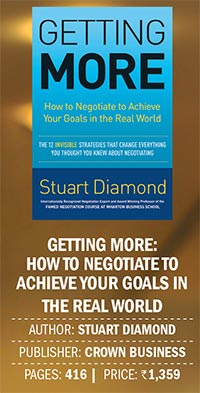
Negotiation is something I do for a living. As the father of a young child, negotiation is something I have to do at home as well, especially if I have to get my daughter to eat her vegetables. My approach to negotiations so far was a rational one, based on facts, and the attempt would always be to arrive at a ‘win-win’ situation for both sides. Most often it worked, sometimes it didn’t. Getting More: How to Negotiate to Achieve Your Goals in the Real World by Stuart Diamond, was an eye-opener.
Diamond is a Pulitzer-winning journalist for The New York Times, a Harvard-trained attorney, Wharton MBA, UN consultant and has served as manager and executive in many sectors. Currently, he teaches a course on negotiation at the Wharton School of the University of Pennsylvania. This book draws upon his vast experience and has several case studies drawn from the work of over 400 of his students. The book’s fundamental premise is that negotiation is at the heart of human interaction. One can’t get away from it, one can only choose to do it well or badly.
In his view, there is no difference between negotiation and persuasion, communication and selling. All four fields are based on achieving goals, are focused on people, and can be situational. All four share the fundamental aim of negotiation, “to meet your goals,” says Diamond.
The author says that since the people involved make up 90% of a negotiation — substance accounting for only 10% — one must negotiate based on one’s understanding of the “pictures in the head of the other party”. He tries to underscore that psychology trumps the issues at the bargaining table. Successful negotiators must learn what makes others tick (through research, observation and small talk), take small steps, communicate clearly, avoid deceit and embrace differences. Above all, he says, they must stay focused on specific goals and connect with the other party.
The book challenges conventional wisdom on every page, from ‘win-win’ to the best alternative approach to the idea of a negotiated agreement. In doing so, he forces readers to think and examine their presumptions and predispositions. Diamond uses over 400 testimonials to showcase how this approach works — ranging from getting a fat discount on an item on sale, earning millions of dollars in profit to an Indian woman getting out of an arranged marriage. These case studies are extremely illustrative. The reader will find the book thought-provoking and useful in a wide variety of situations, from getting a job, getting a raise to closing business deals.
How has reading this book benefited me? While I am not at liberty to discuss the difference it has made to my business negotiations, as far as my daughter is concerned, I have got her to eat her vegetables!











